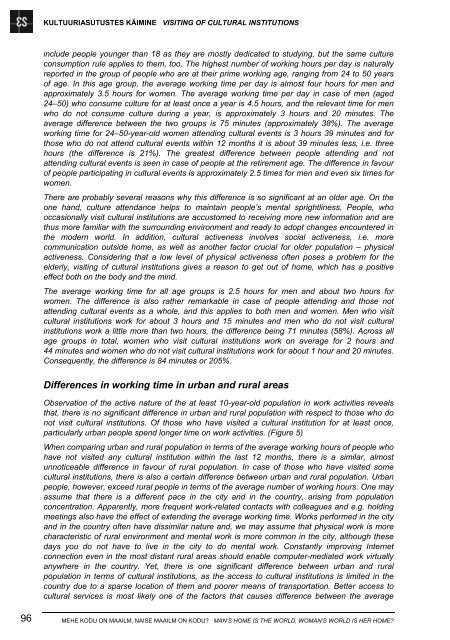MEHE KODU ON MAAILM, NAISE MAAILM ON KODU? - Tartu Ãlikool
MEHE KODU ON MAAILM, NAISE MAAILM ON KODU? - Tartu Ãlikool
MEHE KODU ON MAAILM, NAISE MAAILM ON KODU? - Tartu Ãlikool
Create successful ePaper yourself
Turn your PDF publications into a flip-book with our unique Google optimized e-Paper software.
KULTUURIASUTUSTES KÄIMINE VISITING OF CULTURAL INSTITUTI<strong>ON</strong>S<br />
include people younger than 18 as they are mostly dedicated to studying, but the same culture<br />
consumption rule applies to them, too. The highest number of working hours per day is naturally<br />
reported in the group of people who are at their prime working age, ranging from 24 to 50 years<br />
of age. In this age group, the average working time per day is almost four hours for men and<br />
approximately 3.5 hours for women. The average working time per day in case of men (aged<br />
24–50) who consume culture for at least once a year is 4.5 hours, and the relevant time for men<br />
who do not consume culture during a year, is approximately 3 hours and 20 minutes. The<br />
average difference between the two groups is 75 minutes (approximately 38%). The average<br />
working time for 24–50-year-old women attending cultural events is 3 hours 39 minutes and for<br />
those who do not attend cultural events within 12 months it is about 39 minutes less, i.e. three<br />
hours (the difference is 21%). The greatest difference between people attending and not<br />
attending cultural events is seen in case of people at the retirement age. The difference in favour<br />
of people participating in cultural events is approximately 2.5 times for men and even six times for<br />
women.<br />
There are probably several reasons why this difference is so significant at an older age. On the<br />
one hand, culture attendance helps to maintain people’s mental sprightliness. People, who<br />
occasionally visit cultural institutions are accustomed to receiving more new information and are<br />
thus more familiar with the surrounding environment and ready to adopt changes encountered in<br />
the modern world. In addition, cultural activeness involves social activeness, i.e. more<br />
communication outside home, as well as another factor crucial for older population – physical<br />
activeness. Considering that a low level of physical activeness often poses a problem for the<br />
elderly, visiting of cultural institutions gives a reason to get out of home, which has a positive<br />
effect both on the body and the mind.<br />
The average working time for all age groups is 2.5 hours for men and about two hours for<br />
women. The difference is also rather remarkable in case of people attending and those not<br />
attending cultural events as a whole, and this applies to both men and women. Men who visit<br />
cultural institutions work for about 3 hours and 15 minutes and men who do not visit cultural<br />
institutions work a little more than two hours, the difference being 71 minutes (58%). Across all<br />
age groups in total, women who visit cultural institutions work on average for 2 hours and<br />
44 minutes and women who do not visit cultural institutions work for about 1 hour and 20 minutes.<br />
Consequently, the difference is 84 minutes or 205%.<br />
Differences in working time in urban and rural areas<br />
Observation of the active nature of the at least 10-year-old population in work activities reveals<br />
that, there is no significant difference in urban and rural population with respect to those who do<br />
not visit cultural institutions. Of those who have visited a cultural institution for at least once,<br />
particularly urban people spend longer time on work activities. (Figure 5)<br />
When comparing urban and rural population in terms of the average working hours of people who<br />
have not visited any cultural institution within the last 12 months, there is a similar, almost<br />
unnoticeable difference in favour of rural population. In case of those who have visited some<br />
cultural institutions, there is also a certain difference between urban and rural population. Urban<br />
people, however, exceed rural people in terms of the average number of working hours. One may<br />
assume that there is a different pace in the city and in the country, arising from population<br />
concentration. Apparently, more frequent work-related contacts with colleagues and e.g. holding<br />
meetings also have the effect of extending the average working time. Works performed in the city<br />
and in the country often have dissimilar nature and, we may assume that physical work is more<br />
characteristic of rural environment and mental work is more common in the city, although these<br />
days you do not have to live in the city to do mental work. Constantly improving Internet<br />
connection even in the most distant rural areas should enable computer-mediated work virtually<br />
anywhere in the country. Yet, there is one significant difference between urban and rural<br />
population in terms of cultural institutions, as the access to cultural institutions is limited in the<br />
country due to a sparse location of them and poorer means of transportation. Better access to<br />
cultural services is most likely one of the factors that causes difference between the average<br />
96<br />
<strong>MEHE</strong> <strong>KODU</strong> <strong>ON</strong> <strong>MAAILM</strong>, <strong>NAISE</strong> <strong>MAAILM</strong> <strong>ON</strong> <strong>KODU</strong>? MAN’S HOME IS THE WORLD, WOMAN’S WORLD IS HER HOME?

















